As this is the last blog before its 2-week ‘vacacion’, I thought I would remind readers about the great opportunity for a part-funded MA by Research on a project based around the St Albans Library inventory. Due to the generosity of a local benefactor, this is a chance for someone interested in Book History and Material Culture to investigate a substantial gentry family library collected in the eighteenth and early nineteenth centuries, which covers a very wide range of fascinating subjects. Annotations cover the period up to the auction of the library books in 1938 and the inventory also includes silver and plate, jewels, statues, objects of worth and paintings. This project will draw on comparable ‘great house’ libraries to explore, for example, ideas about collecting and reading habits, as well as the presence of book-sharing networks among this group in Hanoverian and Victorian society. The successful applicant will be offered a bursary of £1000, with the possibility of applying for a further £1000 from the Ian Coulson Award fund. If this sounds exciting and you would like to find out more about the opportunity, please do contact Dr Claire Bartram who will be one of the supervisors: claire.bartram@canterbury.ac.uk
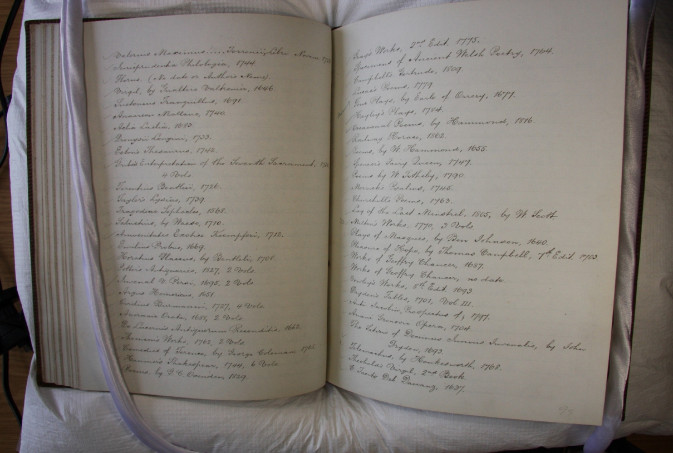
As some may remember, the Centre took part in last month’s highly successful virtual Medieval Pageant, led by the Canterbury BiD with Claire Bartram as the Centre’s co-ordinator. As well as the work of the CCCU Creative Writing team, Dr Diane Heath called for drawings and ideas for medieval tiles with an animal theme to help celebrate the anniversary in an apt way. Many of you kindly joined in the fun and here is the design for the virtual medieval tiled floor in the round chapel where the skull of St Thomas was enshrined at the very easternmost chapel of Canterbury Cathedral.
We received some amazing drawings and inspiring suggestions and from here Diane picks up the story because she has had fun putting the floor together in a way that channels medieval tilers, their encaustic tiles, medieval animals, and current themes too. Encaustic tiles are clay – usually a dark reddish clay, struck with a stamped design that is filled in with a paler slip using a range of earthy colours. The result is nine diamond segments of tiles put together in contrasting tones and separated into four quadrants with a beautiful large tile at the centre – more about that later.
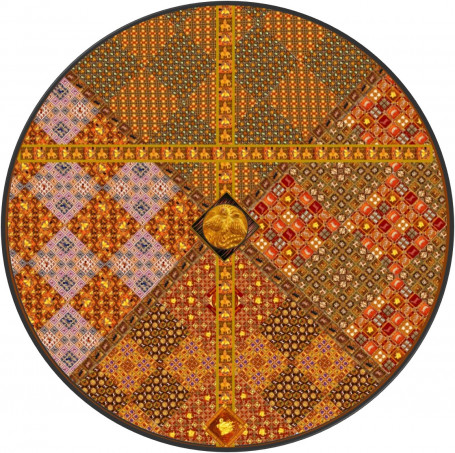
Animals range from a delightful Pig (thank you, Sheila) to Kathryn’s glorious Peacock (here I [Diane] have added purple, for an imperial touch). Dean, a member of the Kent History Postgraduates Group and expert on medieval Jewry, sent Aaron of Colchester to keep our animals under some form of control, while my cousin Jo asked me whether there were black Mermaids (but of course, as they represent every kind of woman). Hitherto I had thought of Mermaids as mostly sea-green so now, thanks to Jo, they are rainbow, a vast improvement. However, it must be said that medieval Mermaids were not sweet Disneyesque creatures but were seen in the Middle Ages as figures representing prostitution and avarice, as men paid for their charming company. More topical, a Kent Bison was drawn by Rosie since the species is about to be reintroduced to our county. As it is such a huge creature, the Bison has been set with a wonderful green Dragon by Sophie and a medieval war Elephant (complete with a castle on its back). The Dragon often was considered the epitome of evil, but it also represented wisdom as the King of Serpents. The Elephant was a suggestion by Peter after he saw a broken medieval tile (held by the V&A) with just the rear of the animal and remarked it must be difficult to fit even part of an elephant on a tile. With serendipity, Douglas (@DevonChurchLand) then posted a photograph of a complete tile on Twitter from Muchelney, so all the Elephant appears in our virtual medieval tiled flooring. Indeed, Elephants also appear in the gold-edged cross, as they were believed to make their way towards Eden to mate and partnered for life so were figures of solidarity and matrimony (and the Church was married to Christ). Elephants alternate on the cross with Bees which medieval people considered represented skill, industriousness, and a love of the kingdom of Heaven, even though they were thought to be born out of corruption.
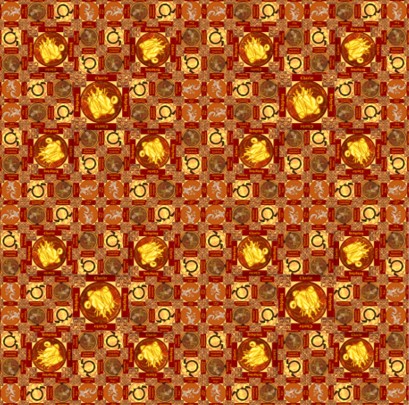
The whole round tiled floor represents a medieval T and O map of the world (orbis terrarum), with as mentioned above, a lesser subdivision into four quadrants indicating animals from all corners of the world. Starting at the top, we have discussed the diamond of Bison, Dragon and Elephant but not its partner. Just as Henry III was so keen on his hunting dogs that it seems he had a fresco of King Garamentes and his loyal hounds painted in his Westminster Palace washroom, here too we have a panel of Hounds, based on designs from Rosie and Helen of Greyhounds and Talbots. Although Talbots are now extinct it is possible they were ancestors of today’s beagles.
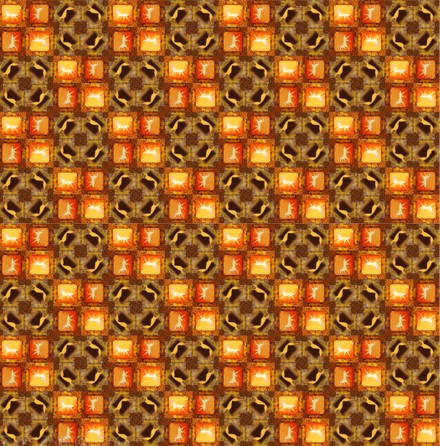
The next quadrant going clockwise has two diamond panels, one in red tones and the second in browns and creams. This latter contains photographs of non-virtual tiles since they were made of iced gingerbread. Lily, just completing her PhD with Dr Sheila Sweetinburgh, made beautiful gingerbread tiles of Doves, a Lion and a Stag, while Helena made Aries the Ram. I placed them within medieval styled tile borders. I hope they tasted as good as they looked. Gingerbread tiles of Aaron by Dean and a Lion, a Dragon, a Bear and the Ram by Helena are also in the adjoining set, together with an Ass in honour of Dr Kathryn Smithies’s new book, Introducing the Medieval Ass out next month from University of Wales Press (a shameless plug by the series editor), Sheila’s Swine and Lily’s Tiger, based on her embroidery of an Bestiary Tiger in BL Add. 11283, fol. 2. They are completed by one of my favourite animals, the Hedgehog. This Hedgehog is very special, having been drawn by Sebastian, aged 4, and named Charlie (although it seems most animals are named Charlie by Sebastian at the moment, it’s still a great name for a hedgehog and much better than my suggestion of Spike). There are various Hedgehogs dotted about the tiled floor because it’s great and also because the Hedgehog, although a figure for heresy, only stole grapes from the Lord’s vineyard to feed her hoglets. I think Christ would have forgiven a few grapes, so the Hedgehog is at the foot of the cross, to remind us to look after our children.
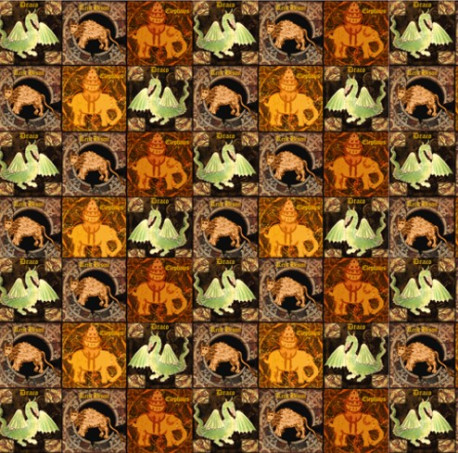
The third quadrant has three squares of designs and forms the entrance to the virtual chapel. Beginning with a large tile of Sebastian’s Hedgehog, the red and yellow diamond also contains Lily’s Tigress outwitted by the hunter who steals her cub, a beautiful Amphisbaena from Rosie (a double-headed snake, with wings), dark brown against a yellow background, and a murky scene featuring the Crocodile (Cocodrillus in Latin as according to Isidore it is the same colour as the yellow crocus, not an attribute that usually springs to mind). Kathryn sent in one of her photographs of a stone carving from Bottesford church in Leicestershire which has been added to a Chertsey tile in the form of bird’s eye view crocodile. The medieval Crocodile represented Hell, and the Hydrus snake that covered itself in mud and was then swallowed whole by the Crocodile was a figure for Christ, because it burst out of the Crocodile’s stomach three days after being eaten alive, as Christ did in the Harrowing of Hell. This diamond sits next to a dark background set that features a lovely Unicorn, a figure of Christ-like purity and two beautiful Mermaids, one black with wings and one redhead but both with the standard mermaid kit of comb and looking-glass. Mermaids have a tangled history involving winged sirens, fishy tails, and occasional duck legs. The third panel features some fun animals – Bop the Dog and Tac the Cat from a younger contributor (Harry), with a gorgeous Snail from Trish. Snails often feature in the borders of medieval illuminated Books of Hours, sometimes fighting mounted knights but losing because a snail’s eyestalks retreat so readily. The fourth creature to form a pattern in this panel is Kathryn’s Peacock from her photograph of a pew-end in Bottesford church. Peacocks were linked to purity because their flesh was incorruptible.
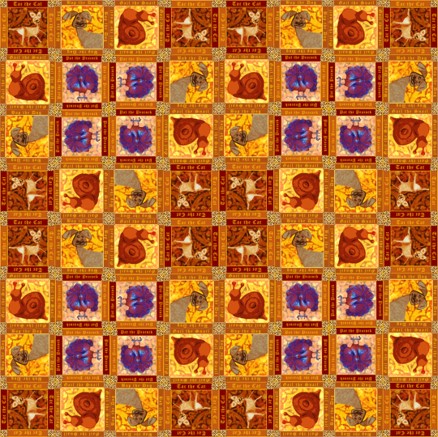
Trish’s work fills our fourth quadrant, since she kindly drew not only the Snail, but also a round, happy Bee. Her third drawing was of a Polpo or Octopus that appears in Peter Damian’s eleventh-century bestiary linked to vulpine craftiness. An Octopus was viewed as having tentacular coils of deceptiveness, as opposed to the straight flight of the humble Bee.
Our final image is particularly appropriate for the Caput Thomae Chapel. The golden bird is the oriental Phoenix, that flies from the East every five hundred years according to Pliny and self-immolates on a nest of Lebanese scented cedarwood. Our hearts go out to the Lebanese whose city of Beirut has just witnessed such a devastating explosion. Medieval Christian syncretism overlaid Pliny to establish the Phoenix’s arrival at Easter; its flaming nest produced egg, then chick, then giant red eagle, making the Phoenix, I suppose, the first Easter egg. It remains the crucial symbol of hope and redemption which is why it is at the centre of our virtual medieval tiled floor. Even more fitting, wall paintings of the Phoenix in its flaming nest once adorned the walls of the chapel and you can still see their ghostly outlines. The Phoenix gives all of us hope in challenging times – the name of the Chapel? It’s called the Corona. . . .
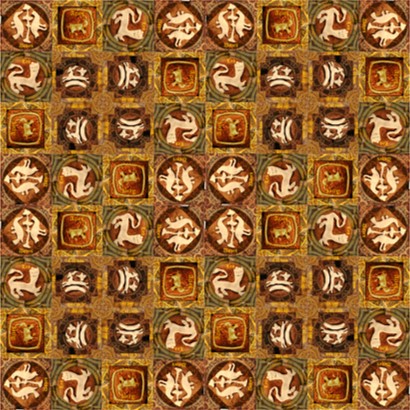
We hope you like the pavement and hopefully will keep reading the Centre’s blog when it returns towards the end of the month.
 Centre for Kent History and Heritage
Centre for Kent History and Heritage Sheila Sweetinburgh
Sheila Sweetinburgh 1974
1974


What a phabulous phantasmagoria of phantasy!
A tribute to the imagination of the medieval mind, and to all those who have managed to adapt it to tilework!
Dear Nicholas: Thank you, I’m glad you like it, Diane will be pleased.
Best wishes, Sheila
A fabulous re-imagining of medieval animals with so many links to the global situation(s) we find ourselves in today.
Thanks Kathryn, yes indeed, as well as forming a great bridge to Becket’s era.
Best wishes, Sheila